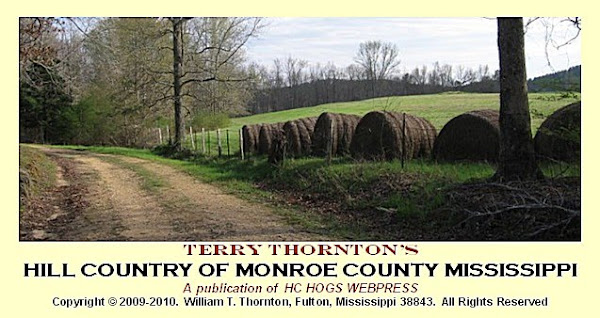by Terry Thornton
email: hillcountrymonroecounty@gmail.com
email: hillcountrymonroecounty@gmail.com
Hill Country Whiskey Still circa 1940s. Photograph of a working whiskey still from the Pottery/Whiskey Hills of extreme northern Monroe County, Mississippi. Note pottery jugs in foreground. Names of individuals shown in the photograph withheld.
Photograph from the family collection of Cathey Vandiver-Spann,
Smithville, Mississippi. Used by permission. All Rights Reserved.
It appears that the operator of the still is holding a glass bottle to the man on the left. Further it appears that the metal drum on the right has a fairly large coil of tubing rising from the top. If so, that coil of tubing (usually copper) was the "worm" of the still, the most important part. The worm is used so that alcohol, which boils off at a lower temperature than water, condenses and drips out of the far end of the worm.
The wooden barrel shown between the two men may have been where the condensed alcohol was collected or it may have contained water to further cool the alcohol gases in the worm causing them to condense into a liquid. A spigot on that collection barrel could be used to fill bottles or jugs with home-distilled whiskey --- or the alcohol collected at the base of the cooling-barrel as it dripped from the far end of the worm.
Located nearby the site of this still were several Hill Country potters, any one of whom could have made the whiskey jug shown in the foreground. Most whiskey jugs, of which thousands were made in the Pottery Hills of Monroe and Itawamba County, were not signed. Potters didn't want their name associated with whiskey making although making whiskey jugs was one of their largest and steady sources of revenue. Some of the potters in the region were also whiskey makers.
Perhaps readers can help sort out the set-up of this still and explain the various parts and their functions. The basic question I have is about the worm: was it an "air cooled" worm or was it "water cooled" worm. If water cooled, then the wooden barrel contained water with the worm passing down through the water and exiting near the bottom where the alcohol was collected.
The only whiskey stills I've seen in Hill Country were after the law enforcement folks had "busted them up." All of those were beside a good source of spring water which was used to prepare the mixtures as well as to cool the worm. The only distillation of alcohol I've ever done was with a class of students in 1961 to whom I was trying to teach chemistry --- we did the standard laboratory exercise and formed alcohol through the action of yeast on a sugar solution and then distilled it. There were about a dozen little stills at work in the lab that day and unfortunately, most of the alcohol was consumed as rapidly as it condensed. I vowed to never do that experiment again except as a demonstration.
It is a treat to see a still and its operator before the still was destroyed by the sheriff. Thanks, Cathey, for sharing this bit of family history and for helping to document our hill country heritage.


No comments:
Post a Comment